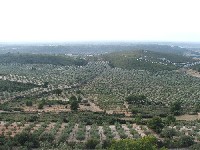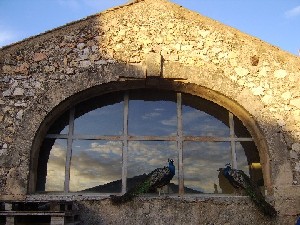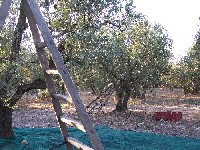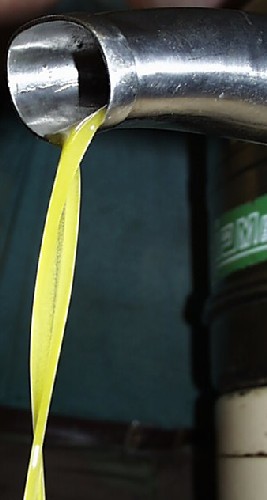 |
Evidence of an oil mill dating back
to the B.C. era has been discovered in Glanum (Saint Rémy
de Provence).
The earliest legal documents we have on oil from the Arles
region are from the third century A.D.
Around 1830, Napoleonic property assessments
registered the oil mills and their calculated values.
Documents such as the 1829 reports on the industrial situation
and the agricultural surveys of 1836 indicate that olive
groves covered around 2117 hectares (5231 acres) in Vallée
des Baux at the time.
|
In 1830,
there were 28 mills in existence: eighteen farmhouse mills
belonging to the aristocracy or the bourgeoisie, five village
mills, and five mills outside the village or in the hamlets.
The mills employed 451 workers.
The frosts of 1820 and 1829 put an end to the construction
of mills. |
|
|
Le
Moulin du Mas de Vaudoret
|
|
The farmhouse is outfitted with high performance
equipment that respects both traditional methods and modern processes
of extraction. This optimizes the characteristic flavors while
guaranteeing perfect hygiene and minimal acidity levels.
Established in November 1997
 |
Annual
Quantity of Olives Milled: 50 to 100 tons
Annual Oil Production: 3,000 to 10,000 liters graded Biologique
du Mas (organic oil produced at the farmhouse)
2,000 liters produced by third parties in private batches
Origins of Organic Produce: from our farm only
Distribution Network: 50% by mail
40% direct sales, tasting rooms, exhibtions
10% small-scale distribution and exports |
Grades of
Olive Oil:
1/ AOC Vallée des Baux de Provence
2/ Single-variety oils:
- Grossane Vintage
- Béruguette Vintage
3/ First Cold Pressed
4/ Extra Virgin
Harvest and Production Period: November and December
back
|
|
Vaudoret
: A Brief History
|
|
The Waton-Chabert family has been a part of
the olive-growing, farming, and pastoral country lifestyle in
Vallée des Baux de Provence et de la Crau since 1860.
The Bezy family raises their olive trees according to organic
farming practices.
The union of the Bezy and Waton-Chabert families, thanks to Edith’s
olives and Mill Master Henry’s expertise, has led to the
fruition of 35 hectares (over 86 acres) of olive farming. This
enterprise combining a farm and a mill is unique to the region
and has been granted an AOC (appellation of controlled origin)
designation and an Agriculture Biologique (organic agriculture)
label.
|
|
Vallée
des Baux Olive Varieties
|
|
-
Salonenque: From the Salon region.
50% from Vallée des Baux plantations.
- Grossane: A Vallée des Baux classic.
Our finest oil, yet still fruity.
10% from Vallée des Baux plantations.
- Béruguette: either Aglandau or Blanquette.
Our most robust oil.
20% from Vallée des Baux plantations. |
-
Verdale: A regional classic.
10% from Vallée des Baux plantations.
- Other local varieties: Picholine, Bizarude, pollinating
varietes.
10% from Vallée des Baux plantations. |
back
 |
Olive
trees do not yield a regular harvest. They flower in May
and the fruit “sets” in June. (fruition and
beginning of the olive's cycle)
The Salonenque harvest is hand-picked in September for preparing
cracked olives.
Green olives are picked in October and black olives in December.
Olive harvesting for oil takes place from the beginning
of November until the end of December.
Each picker harvests up to 100 kilograms (220 pounds) daily,
either by hand or with a net (a net is spread beneath the
tree and a hand rake is used to comb through the branches,
and then the net is gathered up to collect the olives). |
|
|
Oil
Extraction Techniques
|
|
 |
The
oil is cold-extracted mechanically:
The olives are stored between a few hours and a few days,
enough time to begin anaerobic fermentation.
The oil is stored in vats to decant until the end of January
when it is packaged and sold. "New oil", highly
regarded by certain enthusiasts, is the only exception.
There are two methods of oil extraction:
- by pressure (traditional method):
The olives are crushed between two granite wheels. The paste
is spread over filters and pressed, and then the water is
separated out.
- by centrifuge (modern method):
The olives are milled and malaxed. The paste is put into a
centrifuge to separate the oil from the flesh and then from
the water. |
back
|
|
Distinctions
and Recognition
|
|
1995: "Site remarquable du goût" (site of culinary
excellence) of the Conseil National des Arts Culinaires (national
council of culinary arts) awarded to the Vallée des Baux
olive production and the town of Mouriès, top oil-producing
town in France.
1997: Three
"Appellation d'Origine Contrôlée" (appellations
of controlled origin) designated by decree of the French government
for:
- Vallée des Baux olive oil
- Vallée des Baux black olives
- Vallée des Baux cracked olives
 |
Unique
to Le Moulin du Mas de Vaudoret:
- Agrément biologique (certified organic)
- "Qualité France" Certification
- "AB" (organic agriculture) logo of the Minister
of Agriculture
* for the products -olives and oils- produced on the farm
* for the mill (production workshop). |
back
|